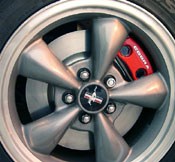|

The mods you make on a project car
should be dictated by how you use the car. It sounds like a
"no duh" statement, but you'd be surprised that most
enthusiasts don't stop to think about this. For example, if
you have a project car that is infrequently driven on the street,
or is trailered to the drag strip, you most likely perform engine
and horsepower related upgrades. On the other hand if you have
a car that doubles as a daily driver, and you commute in city
traffic, it'd be wise to put money into other systems which
will yield usable results. For instance, perhaps you need better
tunes, or the suspension is shot, or as in our case, the car
needs better brakes. Modifications of these sorts aren't going
to help you go any faster, but the point is that going faster
and making more power isn't always what you and your car need.
Spending some money in other areas can also yield noticeable
results and performance of another variety which makes your
ride that much better.
Brakes are one such area that we often settle for, especially
on newer cars. After all it is a reasonable assumption that
a new car has modern brakes and therefore there isn't much to
gain by upgrading. In reality, just like anything else, there
is always room for improvement. Mustang braking systems have
evolved considerably over time. Beginning in 1999 Ford began
putting some admirable brakes on some of the big guns in the
Mustang lineup. The SVT Cobra, Bullitt and Mach 1 models all
came with track worthy 13" front rotors and matching calipers.
While all Mustangs from 1999-2004 are equipped with four wheel
disc brakes, the 13" front brakes was still a sizable step-up
from the GT's 11" rotor setup.
Back in the '60's if the factory made an alternative component
standard on a specific model you had the option to purchase
that upgrade on the base model. Those days are long gone. Since
the late 70's the only way to get parts only sold on Ford premium
makes and models is to purchase it over the parts counter, or
through Ford Racing, afterwards. For that reason if you buy
a 2004 Mustang GT and want Cobra brakes, well don't tell the
dealer because he could care less and Ford simply doesn't play
that way anymore. Fortunately while factory performance programs
have
 |

Top: Stock 11" GT brake rotor.
Bottom: 13" Cobra rotor and caliper fills out the
wheel nicely. |
withered away the aftermarket has flourished.
Companies like Performance Parts Inc. make their business
sourcing and selling OEM performance parts. In some cases
they deal directly with Ford, in other cases they deal with
the original suppliers. In either case the end result is a
supply of original good stuff for us to upgrade our not-so-worthy
base models.
Back to brakes. The '99-'04 Mustang GT
came with 11" rotors up front. Nothing wrong with that
for most people, but for guys who like to drive hard you won't
sleep well at night knowing you could be at Cobra specs for
just $400. Since paying a local shop for a good brake service
with new rotors and pads can approach that cost, we figure
you may as well do it yourself and put what you'd pay in labor
towards a killer looking and performing set of brakes. We
ordered up an entire kit from Performance Parts, which includes
the 10th Anniversary red Cobra calipers and 13" Brembo
rotors. We also spent a few bucks extra to get Goodrich D.O.T.
approved stainless steel hose. The hose isn't necessary but
will resist stretching or ballooning under extreme heat and
pressure. Since we plan to autocross our car we figured this
is cheap insurance.
Furthermore, and if anything, it comes down to aesthetics.
Let's face it, who want's a killer looking car with great
17" or 18" wheels when what is behind them is a
tea saucer? You don't see any of the Euro sports cars coming
with anything but painted aluminum calipers and big pizza
pie rotors. So, follow along and convince yourself how easy
and worthwhile it is, then go out and do it.
Removing the Stock Brakes
|

